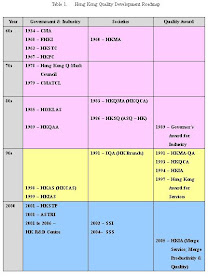I would like to share what I have learnt during the workshop.
What is the different between ISO 9001 and ISO 9004?
ISO 9001 is a requirement. It uses the word “SHALL” for the meaning of mandatory.
ISO 9004 is a guideline. It uses the word “SHOULD” for the meaning of up-to-business.
Dr. Ali briefed the history of quality movement that:
i) QC (focus on inspection – ISO 9001:1987)
ii) QA (focus on Procedure – ISO 9001:1994)
iii) QMS (focus on process approach and continual improvement – ISO 9001:2000 / ISO 9001:2008)
What is Sustained Success?
Sustained success is a result of the ability of an organization to achieve and maintain its objectives in the long term under dynamic organization’s environment.
Organization’s environment is a combination of internal and external factors and conditions that can affect the achievement of an organization’s objectives, and its behaviour towards its interested parties.
The process-based Quality Management System Model was also introduced.

The foundation of sustainable success is based on eight quality management principles. They are “Customer focus”, “Leadership”, “Involvement of people”, “Process approach”, “System approach to management”, “Continual improvement”, “Factual approach to decision making” and “Mutually beneficial supplier relationships”. The following table shows the most significant linkage between principles and ISO 9001 clauses.
It is recognized continually changing environment and it needs to monitor and analyze organization’s environment constantly in order to:
i) obtain data and information on which it can identify need for change,
ii) make decisions in a timely manner for organizational change and innovation, and
iii) maintain and/or improve its performance.
Top management should have the following actions to manage sustained success:
i) long term planning,
ii) constantly monitor and analysis of uncertain organization’s environment,
iii) identification of all its relevant interested parties and keep them informed of the organization’s activities and plans,
iv) consideration of mutually beneficial relationships with suppliers, partners & others,
v) identification of associated short term and long term risks,
vi) anticipation of future resource needs,
vii) regularly assessment of compliance with current plans and procedures,
viii) learning organization culture for maintaining the vitality of the organization, and
ix) processes for innovation and continual improvement.
The following table is an example of interested party and their needs.

The strategy and policy (ISO 9004 – clause 5) is focused on the followings:
i) Planning for business strategy
ii) Formulation a specific actions
iii) Deployment those actions
iv) Communication with all parties
Resources Management is extended to the following items (ISO 9004 – clause 6):
i) Financial
ii) Human resources
iii) Suppliers & partners
iv) Infrastructure
v) Work environment
vi) Knowledge, information & technology
vii) Natural resource
Let’s discuss how to identify, maintain & protect Knowledge and Learning. Several methods would be adopted to achieve the goal such as:
i) learning from failures, near miss situations and successes,
ii) capturing the knowledge and experience of people in the organization,
iii) gathering knowledge from customers, partners and suppliers,
iv) capturing undocumented knowledge (tacit and explicit) that exists within the organization,
v) ensuring the effective communication of important information content, and
vi) managing data and records.
For process planning, it can determine the need for the organization to develop or acquire new technologies; develop new products/services for added value.
In order to ensure that its processes and practices are effective and efficient, it should perform activities such as monitoring, measuring, analyzing, reviewing and reporting.

Monitoring, Measurement, Analysis & Review (ISO 9004 – clause 7) are imported in which will be performed through “Key performance indicators”, “Self-assessment”, “Internal audit” and “Bench-marking”.
Finally, Improvement, Innovation & Learning (ISO 9004 – clause 7) are discussed and it should be applied to:
i) products,
ii) processes and their interfaces,
iii) structures,
iv) management systems,
v) human aspects and culture,
vi) infrastructure, work environment and technology, and
vii) relations with relevant interested parties.
Applications of eight management principles though ISO 9004 guideline could enhance organization maturity. Lastly, “Understanding and satisfying needs & expectations of interested parties” and “Monitoring changes in organization’s environment” are considered to be successful factors for business sustainability.
Photo with Dr. Ali

For more information, please visit http://www.imsa-ltd.com/, http://www.hkqaa.org/.
Reference:
ISO 9001 (2008), Quality Management System – Requirement, International Organization for Standardization, Geneva.
ISO/FDIS 9004 (2009) or ISO 9004:2000, Quality Management System – Guidelines for performance improvement, International Organization for Standardization, Geneva.














































